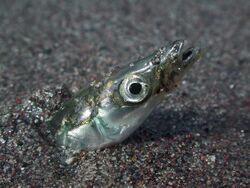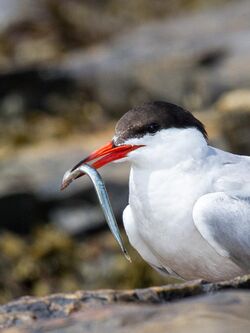Biology:Sand lance
| Sand lances | |
|---|---|

| |
| Ammodytes hexapterus | |
| Scientific classification | |
| Domain: | Eukaryota |
| Kingdom: | Animalia |
| Phylum: | Chordata |
| Class: | Actinopterygii |
| Order: | Trachiniformes |
| Family: | Ammodytidae Bonaparte, 1832 |
| Genera[1] | |
|
Ammodytes | |
A sand lance or sandlance is a fish belonging to the family Ammodytidae. Several species of sand lances are commonly known as "sand eels", though they are not related to true eels. Another variant name is launce,[2] and all names of the fish are references to its slender body and pointed snout. The family name (and genus name, Ammodytes) means "sand burrower", which describes the sand lance's habit of burrowing into sand to avoid tidal currents.
Sand lances are most commonly encountered by fishermen in the North Pacific and North Atlantic, but are found in oceans throughout the world. These fish do not have pelvic fins and do not develop swim bladders, staying true to their bottom-dwelling habit as adults. Both adult and larval sea lances primarily feed on copepods. Larval forms of this fish are perhaps the most abundant of all fish larvae in areas such as the northwest Atlantic, serving as a major food item for cod, salmon, whales[3] and other commercially important species. As adults, sand lances are harvested commercially in some areas (primarily in Europe), leading to direct human competition with diving birds such as puffins, auks, terns, and cormorants. Some species are inshore coastal dwellers, and digging for sand lances to use as a bait fish has been a popular pastime in coastal areas of Europe and North America. Other species are deep-water dwellers, some of which have only recently been described to science, and most of which lack common names.
Chameleon like
Sand lances have chameleon-like independent eye movements and special focusing lenses. Sand lance also have a tongue that can quickly dart out of its mouth at high velocity, a ballistic tongue. Sand lances and chameleons share other features.[4][5][6]
Timeline
<timeline> ImageSize = width:1000px height:auto barincrement:15px PlotArea = left:10px bottom:50px top:10px right:10px
Period = from:-65.5 till:10 TimeAxis = orientation:horizontal ScaleMajor = unit:year increment:5 start:-65.5 ScaleMinor = unit:year increment:1 start:-65.5 TimeAxis = orientation:hor AlignBars = justify
Colors =
#legends id:CAR value:claret id:ANK value:rgb(0.4,0.3,0.196) id:HER value:teal id:HAD value:green id:OMN value:blue id:black value:black id:white value:white id:cenozoic value:rgb(0.54,0.54,0.258) id:paleogene value:rgb(0.99,0.6,0.32) id:paleocene value:rgb(0.99,0.65,0.37) id:eocene value:rgb(0.99,0.71,0.42) id:oligocene value:rgb(0.99,0.75,0.48) id:neogene value:rgb(0.999999,0.9,0.1) id:miocene value:rgb(0.999999,0.999999,0) id:pliocene value:rgb(0.97,0.98,0.68) id:quaternary value:rgb(0.98,0.98,0.5) id:pleistocene value:rgb(0.999999,0.95,0.68) id:holocene value:rgb(0.999,0.95,0.88)
BarData=
bar:eratop bar:space bar:periodtop bar:space bar:NAM1 bar:NAM2
bar:space bar:period bar:space bar:era
PlotData=
align:center textcolor:black fontsize:M mark:(line,black) width:25 shift:(7,-4) bar:periodtop from: -65.5 till: -55.8 color:paleocene text:Paleocene from: -55.8 till: -33.9 color:eocene text:Eocene from: -33.9 till: -23.03 color:oligocene text:Oligocene from: -23.03 till: -5.332 color:miocene text:Miocene from: -5.332 till: -2.588 color:pliocene text:Plio. from: -2.588 till: -0.0117 color:pleistocene text:Pleist. from: -0.0117 till: 0 color:holocene text:H.
bar:eratop from: -65.5 till: -23.03 color:paleogene text:Paleogene from: -23.03 till: -2.588 color:neogene text:Neogene from: -2.588 till: 0 color:quaternary text:Q.
PlotData=
align:left fontsize:M mark:(line,white) width:5 anchor:till align:left
color:eocene bar:NAM1 from: -55.8 till: 0 text: Ammodytes color:miocene bar:NAM2 from: -15.97 till: 0 text: Hyperoplus
PlotData=
align:center textcolor:black fontsize:M mark:(line,black) width:25
bar:period from: -65.5 till: -55.8 color:paleocene text:Paleocene from: -55.8 till: -33.9 color:eocene text:Eocene from: -33.9 till: -23.03 color:oligocene text:Oligocene from: -23.03 till: -5.332 color:miocene text:Miocene from: -5.332 till: -2.588 color:pliocene text:Plio. from: -2.588 till: -0.0117 color:pleistocene text:Pleist. from: -0.0117 till: 0 color:holocene text:H.
bar:era from: -65.5 till: -23.03 color:paleogene text:Paleogene from: -23.03 till: -2.588 color:neogene text:Neogene from: -2.588 till: 0 color:quaternary text:Q.
</timeline>
See also
The sand lance has lent its name to two submarines of the United States Navy:
- USS Sand Lance (SS-381), a Balao-class submarine.
- USS Sand Lance (SSN-660), a Sturgeon-class nuclear submarine.
References
- Bigelow, H. B.; Schroeder, W. C. (1953). "Sand launce Ammodytes americanus De Kay 1942, in Fishes of the Gulf of Maine, Fishery Bulletin 74". Fishery Bulletin of the Fish and Wildlife Service 53. http://www.gma.org/fogm/Ammodytes_americanus.htm.
- biologists.org on independent eye movements
- Sepkoski, Jack (2002). "A compendium of fossil marine animal genera". Bulletins of American Paleontology 364: 560. http://strata.ummp.lsa.umich.edu/jack/showgenera.php?taxon=611&rank=class. Retrieved 2011-05-19.
- ↑ Froese, Rainer, and Daniel Pauly, eds. (2012). "Ammodytidae" in FishBase. December 2012 version.
- ↑ Bigalow & Schroeder, 1953
- ↑ "Do Whales Have Culture? Humpbacks Pass on Behavior". News.nationalgeographic.com. http://news.nationalgeographic.com/news/2013/13/130425-humpback-whale-culture-behavior-science-animals/. Retrieved 2013-04-28.
- ↑ John D. Pettigrew, Shaun P. Collin, and Matthias Ott, “Convergence of Specialised Behaviour, Eye Movements and Visual Optics in the Sandlance (Teleostei) and the Chameleon (Reptilia),” Current Biology 9 (April 1999): 421–24, doi:10.1016/S0960-9822(99)80189-4
- ↑ Michael F. Land, “Visual Optics: The Sandlance Eye Breaks All the Rules,” Current Biology 9 (April 1999): R286–88, doi:10.1016/S0960-9822(99)80180-8.
- ↑ Chameleons And Their Amazing Tongues, November 6, 2022, biobubblepets.com
External links
- Sand Lance profile at Fisheries and Oceans Canada
Wikidata ☰ Q695712 entry
 |



